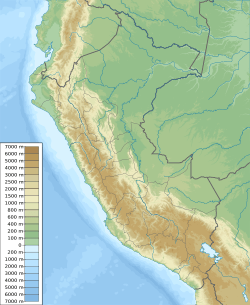Sillustani facts for kids

The tallest chullpa of Sillustani, about 12m high
|
|
| Location | Puno, Puno Region, Peru |
|---|---|
| Coordinates | 15°43′16″S 70°09′30″W / 15.72111°S 70.15833°W |
| Type | Cemetery |
| History | |
| Cultures | Qulla people |
Sillustani is an ancient cemetery in Peru. It's located near the city of Puno, right by the beautiful Lake Umayo. This special place has tall, tower-like tombs called chullpas.
These tombs were built by the Qulla people. They were a group of Aymara who lived here before the Inca took over in the 1400s. The chullpas were used to bury important families, likely nobles or leaders. Sadly, some tombs were damaged by people looking for treasures. Others were never finished.
What are Chullpas?
The chullpas at Sillustani are big stone towers. They were built to hold the bodies of important Aymara people. The Aymara believed it was very important to honor their dead family members.
These tower tombs are found in many places across the Andes mountains. But Sillustani has some of the best and most complete examples. The idea of burying people above ground in towers goes back a long time, even before the Inca.
Inside the Tombs
The inside of a chullpa was made to hold many people. Whole families, especially important ones, were buried together. The dry air inside the sealed tombs helped the bodies stay preserved for hundreds of years. Most bodies were placed in a curled-up position, like a baby before birth.
Some of the stone tombs even have cool animal shapes carved into them. The only opening in these buildings always faces east. This was because people believed the Sun was reborn each day by Mother Earth in the east.
How Were They Built?
The way the chullpas were built is very impressive. Many people think the building style here is even more complex than typical Incan architecture.
The Qulla people used rectangular stones with very straight edges. This is different from the Inca, who often used stones of many different shapes. One of the chullpas still has a large ramp next to it. This ramp shows how the builders might have moved and stacked the heavy stones to create the tall walls.
See also
 In Spanish: Sillustani para niños
In Spanish: Sillustani para niños







